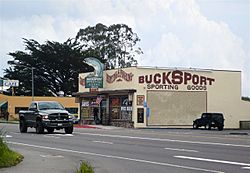Bucksport, California facts for kids
Quick facts for kids
Bucksport
Kucuwalik
Buck's Port
|
|
|---|---|

Bucksport is now a part of Eureka, California.
|
|
| Country | United States |
| State | California |
| County | Humboldt County |
| Elevation | 16 ft (5 m) |
Bucksport (also known as Buck's Port) was once a small town in Humboldt County, California. It was located about 2.5 miles (4 km) southwest of downtown Eureka. The town was right on Humboldt Bay, about 5 miles (8 km) from the bay's entrance. Before American settlers arrived, a Wiyot village called Kucuwalik existed in this very spot.
The town of Bucksport was planned in 1850 by David A. Buck. He was part of a group led by Josiah Gregg who explored Humboldt Bay in 1849. Bucksport even had its own post office from 1855 to 1863.
In 1853, Fort Humboldt was built on a hill overlooking Bucksport. It was commanded by Lieutenant Colonel Robert C. Buchanan. Bucksport was a separate community for a while in the 1800s. However, the nearby town of Eureka grew larger and had better port facilities. By 1870, Bucksport was no longer a separate town. The area became a neighborhood in southern Eureka.
Contents
Bucksport and Elk River Railroad
Building a Railroad for Lumber
Two important sawmill owners on Humboldt Bay were John Dolbeer and William Carson. They formed a partnership called Dolbeer and Carson. In 1885, they built a special railroad from Bucksport. This railroad went south along the Elk River. Its main purpose was to transport giant redwood logs. These logs came from forests about 12 miles (19 km) inland.
The railroad brought the logs to a special area on Humboldt Bay called a log dump. From there, the logs could float easily to sawmills located along the bay. By 1887, three different sawmills relied on this railroad to get their logs.
Life in Falk and More Railroads
Noah Falk created a company town called Falk. It was built around his Elk River Mill and Lumber Company sawmill. This sawmill was near the end of the railroad line, further inland. By 1895, Dolbeer and Carson had cut most of their redwood trees in the Elk River area. But the railroad remained very important for Falk's sawmill. It was the main way for them to ship lumber and receive supplies.
The Elk River Mill and Lumber Company added some smaller logging lines. They used two special steam locomotives called 0-4-0 tank locomotives. These locomotives were built by a company called Marshutz & Cantrell. You can still see these old locomotives today at Fort Humboldt State Historic Park. In 1927, the railroad got an upgrade with a new 24-ton Heisler locomotive. When the Falk sawmill closed in 1937, this Heisler locomotive was sold. It was later changed to run on a diesel engine and is also preserved.
Changes and End of the Line
In 1904, another branch line was built. This line went north from Bucksport to Holmes Mill, which is now part of Eureka. This new line brought in more business for the railroad. The railroad became even more important in 1931 when a branch was built to Camp Carson.
On May 14, 1932, the line officially became the Bucksport and Elk River Railroad Company. J.M. Carson was its president. The original locomotives were retired in 1934. They were replaced by other locomotives from the Dolbeer and Carson Lumber Company.
In 1950, the land with the railroad was sold to the Pacific Lumber Company (PALCO). PALCO continued to operate the railroad until January 15, 1953. After that, new roads for log trucks were built. These trucks could bring logs directly to PALCO's log deck at Yager Creek. The railroad tracks were removed in April 1953. However, one of the locomotives, number 5, was saved and is now on display in Scotia. Locomotive number 3 was also saved and is now part of the California State Railroad Museum.
Locomotives of the Bucksport and Elk River Railroad
Here are some of the locomotives that worked on the Bucksport and Elk River Railroad:
| Road Number | Builder | Type | Year Built | Notes |
|---|---|---|---|---|
| No. 1 | Baldwin Locomotive Works | 2-4-2 tank locomotive | 1889 | Originally Southern Pacific #383. Later became Humboldt Northern #1. |
| No. 2 | Baldwin Locomotive Works | 2-6-2 | 1904 | Built for a special display at the Lewis and Clark Centennial Exposition. Later became Humboldt Northern #2. |
| No. 3 | Baldwin Locomotive Works | 2-6-2 | 1922 | Originally Humboldt Northern #3. Now preserved at the California State Railroad Museum. |
| No. 4 | Lima Locomotive Works | 3-truck Shay locomotive | 1931 | Built specifically for the Bucksport and Elk River RR. Was later sold and scrapped. |
| No. 5 | Heisler Locomotive Works | 2-truck Heisler locomotive | 1920 | Originally Mount Tamalpais and Muir Woods Railway #9. Now on display in Scotia, CA. |


